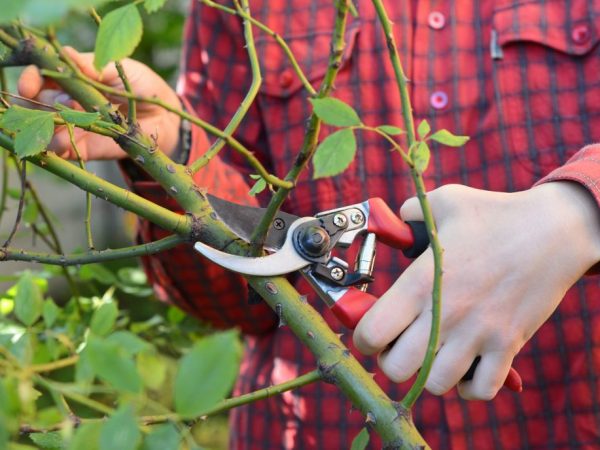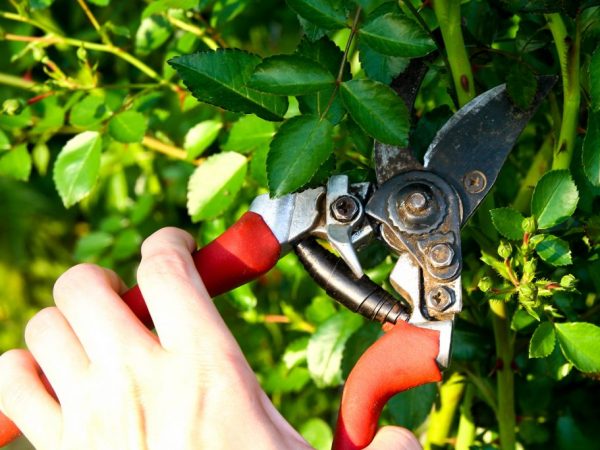Autumn pruning of a climbing rose - we increase the decorative effect of the shrub
The reason for the popularity of the curly rose lies in its high decorative effect, unpretentious care and long flowering throughout the season. These plants adorn many summer cottages as an element of vertical compositions. They look great on designer tapestries, near columns and the front entrance to a dwelling or to a veranda. One of the fundamental aspects of growing comfortably is to properly prune climbing roses for the winter.

Autumn pruning of a climbing rose - we increase the decorative effect of the shrub
The goals of the autumn haircut
The climbing rose is considered unpretentious to care for and quite hardy against the background of other varieties. She needs pruning due to the rapid growth of shoots.
If this event is ignored, it makes no sense to expect abundant flowering from the plant - it will devote all its strength to the development of new shoots.
Tasks for an autumn haircut:
- removal of old and damaged parts, as a result - increased frost resistance and immunity to ailments;
- normalization of aeration and lighting of segments located in the thick of the crown;
- elimination of buds wilted after flowering;
- activation of the growth of vegetative mass;
- prevention of fungal diseases;
- simplification of the shelter procedure for the winter;
- an increase in the flowering period;
- stimulation of the development of replacement branches, due to which the culture is rejuvenated in a turbo mode;
- the formation of a strong support and the necessary direction of the branches.
A feature of a curly rose is its ability to rejuvenate on its own. A similar effect is achieved by actively releasing new shoots replacing old ones. The gardener can only slightly help the lush beauty by eliminating unnecessary segments.
In case of insufficient experience, you can use a simplified scheme for pruning a climbing plant:
- Remove all dried parts at the very base.
- Trim the branches of the bush by ⅓ of the entire length.
Timing
The main criterion for the procedure is the air temperature at night -3 °. In the middle lane, similar climatic conditions are established in mid-October.
Carrying out an event at an earlier date can lead to the unplanned formation and development of buds, as a result, new segments of the rose will die under the influence of cold weather.
In order for a flower to easily endure the stress of a haircut, it is necessary to prepare for it in advance:
- until the first days of August, they completely refuse to apply fertilizers containing nitrogenous compounds;
- increase the dosage of phosphorus and potassium supplements;
- leave wilted buds so as not to provoke the growth of new buds.
Cutting technology
Works are carried out only in dry sunny weather.
Use a pruner, a fine-toothed garden hacksaw, and a knife. The tool must be well disinfected and sharpened. The cut is made smooth, without chipping.
Shoots are cut at an angle of 45 °, just above the bud - this will protect it from the accumulation of excess moisture.

Pruning begins with damaged shoots
When carrying out a sanitary procedure, the branch dries up without touching healthy wood. Above the most suitable kidney, a distance of 5-8 mm is maintained. When choosing, preference is given to a well-developed, outward-looking, retaining only one outgrowth from it.
Stages:
- First of all, woody and damaged shoots are removed.
- No more than 6 branches of the current season are left on each bush. Additionally, all segments of a white shade that freeze under the influence of frost are completely removed. The shoots at the base with small leaf plates are subjected to similar transformations, the development of which can lead to the feralization of the culture.
- Places of cuts are treated with garden varnish. Also, as a disinfectant, it is allowed to use ash, copper sulfate, potassium permanganate.
- Waste must be disposed of, preferably incinerated. This will prevent the possible spread of diseases to healthy shrubs.
Follow-up care
After pruning, you need to treat the climbing rose with an antifungal drug, then prepare it for winter.
It is necessary to carry out mulching of the periosteal circle. Sawdust, pine needles, humus, a mixture of soil and peat are used as material.
The shelter is constructed in the form of a multi-level dome: the first layer is any available insulation; followed by spruce branches and polyethylene on top. A similar structure is reinforced at the edges with a metal profile or bricks.
An alternative way is to build an impromptu greenhouse from bent iron rods.
An ordinary greenhouse film is not suitable as a heater - under it there is an increased humidity of the air, to which the flower is extremely susceptible. The best option is agrofiber with high breathability.
The exceptions are regions with a harsh climate - in such regions, polyethylene is very suitable.
When several roses are close, proceed as follows:
- At the same distance along the ridge, garden arches are inserted into the ground.
- Wooden slats are attached on top so that two are on the sides, one on the top.
- Pull roofing paper or any rubberized material, the bottom of which is securely fixed to the ground.
This approach allows, if necessary, to ventilate the bushes and thereby eliminate the problem of high humidity. To achieve the result, it is enough to move the side flap of the structure.
Mistakes that gardeners make
With insufficient experience in growing ornamental plants, novice gardeners can make a number of mistakes:
- Abuse of dressings, which are introduced in excess in the autumn period in order to recover more quickly after a haircut. As a result of an overdose of fertilizers with a high nitrogen content and complex preparations, the growth of young shoots is activated, which are not able to endure wintering.
- Neglecting the timing of the work. Any, even minor, pruning provokes the plant to form new buds. It is allowed to carry out activities only after the establishment of the first subzero temperatures during the period of slow sap flow.
- Incorrect harvesting of wilted buds. With the right approach, it is allowed to remove inflorescences that have outlived their term only at the beginning of the flowering season. Otherwise, new buds are formed, and the plant begins to spend energy on their life support. As a result, the shrub becomes weaker and becomes unable to withstand temperature fluctuations.
- Neglect of waste collection, which has a particularly detrimental effect on the state of the culture when located in an area with a humid climate. The remaining fallen leaves provide excellent conditions for the spread of fungal spores.
- Lack of disinfection of sections or its untimely implementation.
- Low quality shelter with greenhouse effect.As a result, the plant begins to rot and dies from mold by the beginning of the next season.

